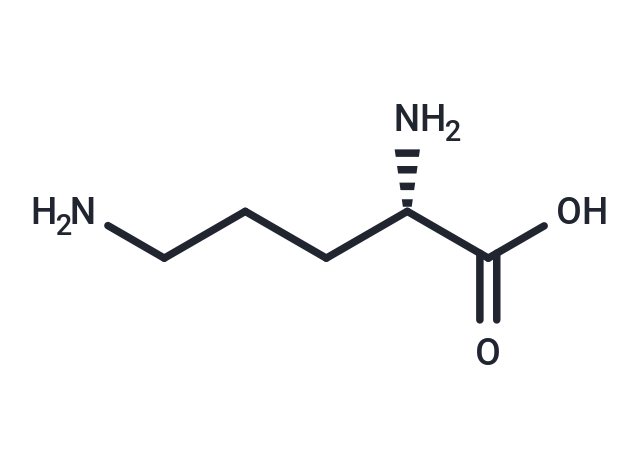Shopping Cart
Remove All Your shopping cart is currently empty
Your shopping cart is currently empty
L-Ornithine ((S)-2, 5-diaminopentanoic acid) is a non-protein amino acid. L-Ornithine is mainly used in the urea cycle to remove excess nitrogen from the body. L-Ornithine is renoprotective. L-Ornithine has antifatigue effects.

| Pack Size | Price | USA Warehouse | Global Warehouse | Quantity |
|---|---|---|---|---|
| 50 mg | $30 | In Stock | In Stock | |
| 100 mg | $42 | In Stock | In Stock |
| Description | L-Ornithine ((S)-2, 5-diaminopentanoic acid) is a non-protein amino acid. L-Ornithine is mainly used in the urea cycle to remove excess nitrogen from the body. L-Ornithine is renoprotective. L-Ornithine has antifatigue effects. |
| Targets&IC50 | Arginase (bovine):1.02 mM (Ki) |
| In vitro | METHODS: HK-2 cells were treated with L-Ornithine (100, 300 μM) for 24 hours, and ROS levels were measured using fluorescence microscopy. RESULTS: Ornithine protected HK-2 cells from ROS production. [1] |
| In vivo | METHODS: To investigate the effect of L-Ornithine on peripheral clock gene expression, mice were orally treated with L-Ornithine (1000 mg/kg) for 3 days. RESULTS: The phase of PER2 gene expression in liver, submandibular gland and kidney was significantly advanced in L-Ornithine treated mice. [2] METHODS: To investigate the effect of L-Ornithine on sleep behavior, L-Ornithine was added to the diet of maternal mice, and its effect on the sleep behavior of offspring mice was observed. RESULTS: L-Ornithine supplementation increased sleep-like behavior in mice. [3] METHODS: To study the effect of L-Ornithine on acute necrotizing pancreatitis, rats were intraperitoneally injected with L-Ornithine (3 g/kg). RESULTS: Severe acute necrotizing pancreatitis was induced by L-Ornithine in rats. [4] |
| Synonyms | (S)-2,5-Diaminopentanoic acid |
| Molecular Weight | 132.16 |
| Formula | C5H12N2O2 |
| Cas No. | 70-26-8 |
| Smiles | NCCC[C@H](N)C(O)=O |
| Relative Density. | 1.165 g/cm3 |
| Storage | store under nitrogen | Powder: -20°C for 3 years | In solvent: -80°C for 1 year | Shipping with blue ice/Shipping at ambient temperature. | |||||||||||||||||||||||||||||||||||
| Solubility Information | DMSO: Insoluble H2O: 50 mg/mL (378.33 mM), Sonication is recommended. | |||||||||||||||||||||||||||||||||||
Solution Preparation Table | ||||||||||||||||||||||||||||||||||||
H2O
| ||||||||||||||||||||||||||||||||||||
| Size | Quantity | Unit Price | Amount | Operation |
|---|

Copyright © 2015-2025 TargetMol Chemicals Inc. All Rights Reserved.